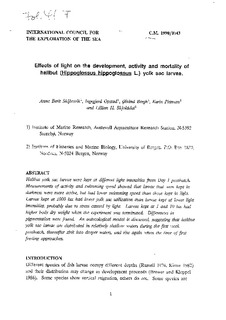| dc.contributor.author | Skiftesvik, Anne Berit | |
| dc.contributor.author | Opstad, Ingegjerd | |
| dc.contributor.author | Bergh, Øivind | |
| dc.contributor.author | Pittman, Karin | |
| dc.contributor.author | Skjolddal, Lillian | |
| dc.date.accessioned | 2012-08-21T14:33:34Z | |
| dc.date.available | 2012-08-21T14:33:34Z | |
| dc.date.issued | 1990 | |
| dc.identifier.citation | This report is not to be cited without prior reference to the authors | no_NO |
| dc.identifier.uri | http://hdl.handle.net/11250/104743 | |
| dc.description.abstract | Halibut yolk sac larvae were kept at different light intensities from Day 1 posthatch.
Measurements of activity and swimming speed showed that larvae that were kept in
darkness were more active, but had lower swimming speed than those kept in light.
Larvae kept at 1000 lux had lower yolk sac utilization than larvae kept at lower light
intensities, probably due to stress caused by light. Larvae kept at 1 and 10 lux had
higher body dry weight when the experiment was terminated. Differences in
pigmentation were found. An autecological model is discussed, suggesting that halibut
yolk sac larvae are distributed in relatively shallow waters during the first week
posthatch, thereafter sink into deeper waters, and rise again when the time of first
feeding approaches. | no_NO |
| dc.language.iso | eng | no_NO |
| dc.publisher | ICES | no_NO |
| dc.relation.ispartofseries | ICES CM Documents;1990/F:43 | |
| dc.subject | halibut | no_NO |
| dc.subject | kveite | no_NO |
| dc.subject | juveniles | no_NO |
| dc.subject | yngel | no_NO |
| dc.title | Effects of light on the development, activity and mortality of halibut (Hippoglossus hippoglossus L.) yolk sac larvae | no_NO |
| dc.type | Working paper | no_NO |
| dc.subject.nsi | VDP::Agriculture and fishery disciplines: 900::Fisheries science: 920::Resource biology: 921 | no_NO |
| dc.subject.nsi | VDP::Agriculture and fishery disciplines: 900::Fisheries science: 920::Aquaculture: 922 | no_NO |
| dc.source.pagenumber | 16 s. | no_NO |
